As noted on the previous page, I've already discovered an error. It's early enough, that I've gone back and corrected everything. But after a graph or two, such corrective measures become onerous. And I find it easier to simply own up to my mistake and move on.
By my count, there were 73 Cases in the 2018 Term Year: a fact which is easily verifiable by simply going to The Supreme Court's Website and noting the final case is R-73. One of those cases was dismissed as being Improvidently Granted (R-32), which leaves 72 Cases for analysis.
Kavanaugh weighed in on 65 of those cases. While the remaining Justices either Authored an Opinion or Joined an Opinion on all 72 Cases.
Now, I remember Kavanaugh's absence. But I thought I remembered someone else recusing themselves at least once. Oh, well. I guess not... or we already have our next error.
Brett
Stuff
Judging the Judges
Term Year: 2018
2018 Term Year Analysis
Fun With Numbers and Graphs
Sanity Check
Opinions Authored
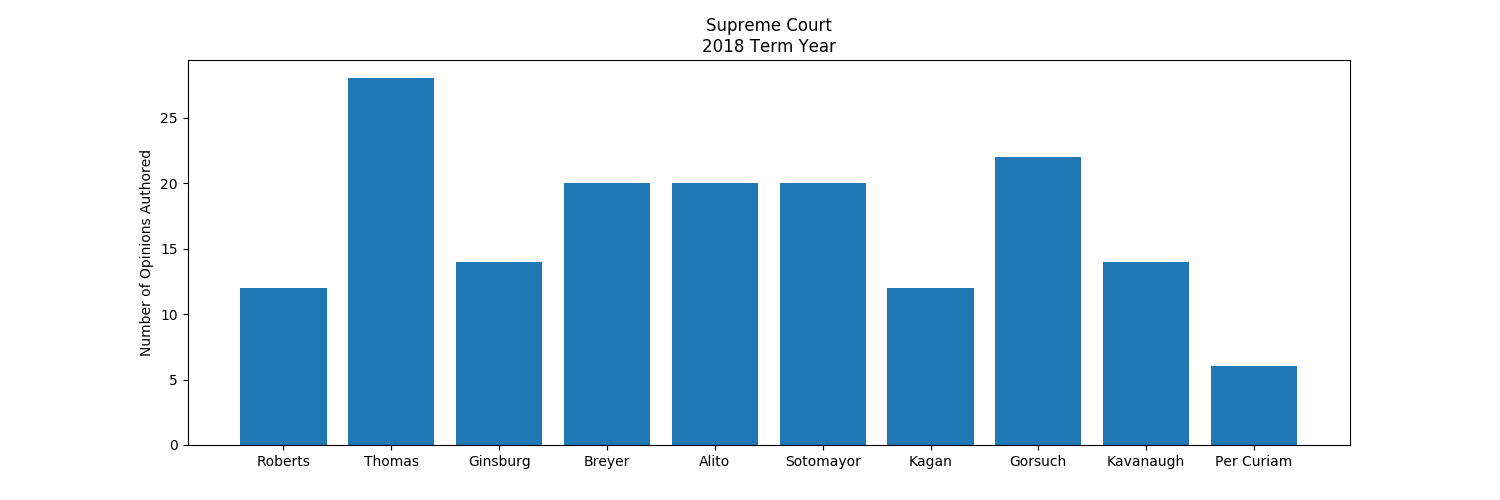
Number of Cases Each Justice Authored
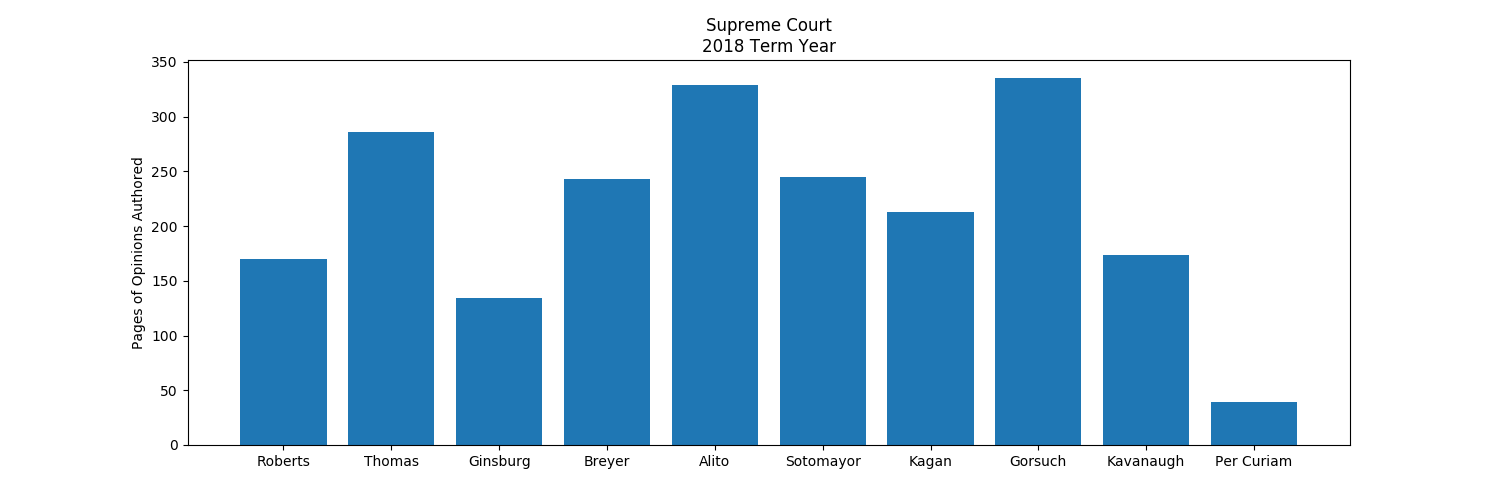
Total Number of Pages Each Justice Authored
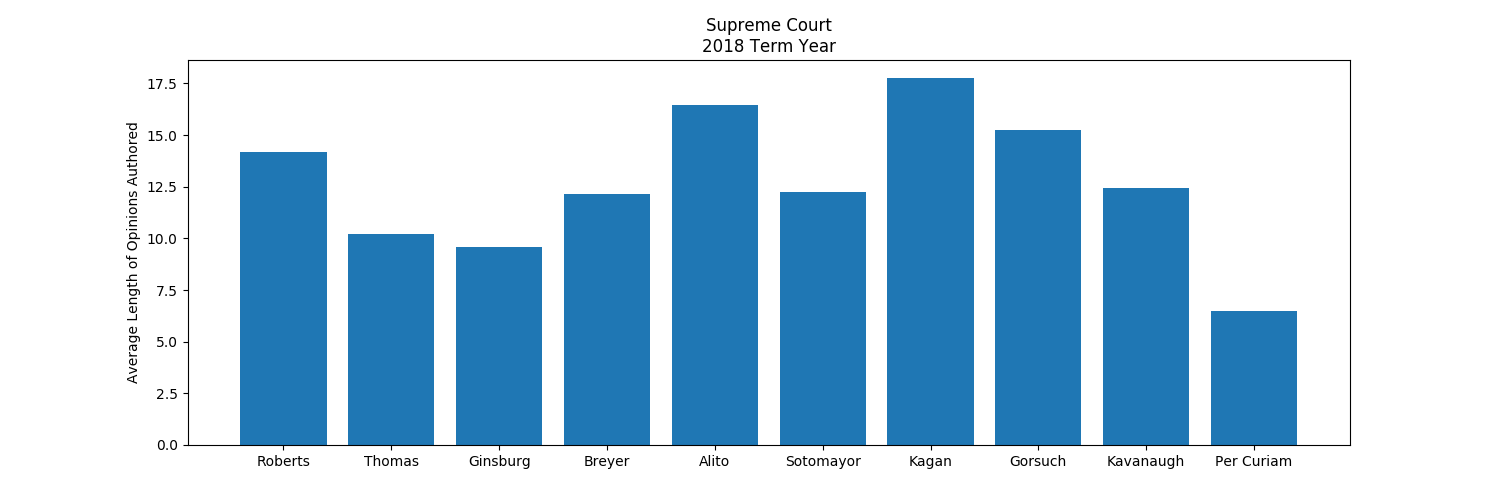
Average Length of Each Authored Opinion
As per above, except in tabular form:
Number is a Count.
Pages is a Summation.
Average is Summation/Count.
Thomas wrote more Opinions that anyone else, so maybe that's one of the reasons why his name stuck out previously. Certainly, I had something to say (in my write-ups) about every decision. And if I were on The Court, I may well be motivated to say a few words in regards to each and every Case.
Now, as much as I like Gorsuch, I am of the belief shorter is better when it comes to legal writing.
A Good Legal Opinion is short.
Enough said.
Ginsburg has the smallest average. But surprisingly, Thomas comes in a close second.
Finally, Per Curium means 'Per The Court'. And as no one gets credit for writing these Opinions, it should not be too surprising they are the shortest.
| Judge | Number | Pages | Average |
|---|---|---|---|
| Roberts | 12 | 170 | 14.17 |
| Thomas | 28 | 286 | 10.21 |
| Ginsburg | 14 | 134 | 9.57 |
| Breyer | 20 | 243 | 12.15 |
| Alito | 20 | 329 | 16.45 |
| Sotomayor | 20 | 245 | 12.25 |
| Kagan | 12 | 213 | 17.75 |
| Gorsuch | 22 | 335 | 15.23 |
| Kavanaugh | 14 | 174 | 12.43 |
| Per Curiam | 6 | 39 | 6.50 |
Number is a Count.
Pages is a Summation.
Average is Summation/Count.
Thomas wrote more Opinions that anyone else, so maybe that's one of the reasons why his name stuck out previously. Certainly, I had something to say (in my write-ups) about every decision. And if I were on The Court, I may well be motivated to say a few words in regards to each and every Case.
Now, as much as I like Gorsuch, I am of the belief shorter is better when it comes to legal writing.
Shorter is better when it comes to legal writing.A Good Law is short.
Freedom of Speech is sacrosanct. The ONLY exception is for reasons of National Security with the onus of proof on The Government.
Morality Laws are contradictory to both the ideal of Freedom of Religion and the Liberty to Pursue Happiness.
A Good Legal Opinion is short.
Enough said.
Ginsburg has the smallest average. But surprisingly, Thomas comes in a close second.
Finally, Per Curium means 'Per The Court'. And as no one gets credit for writing these Opinions, it should not be too surprising they are the shortest.
Solitary Decisions
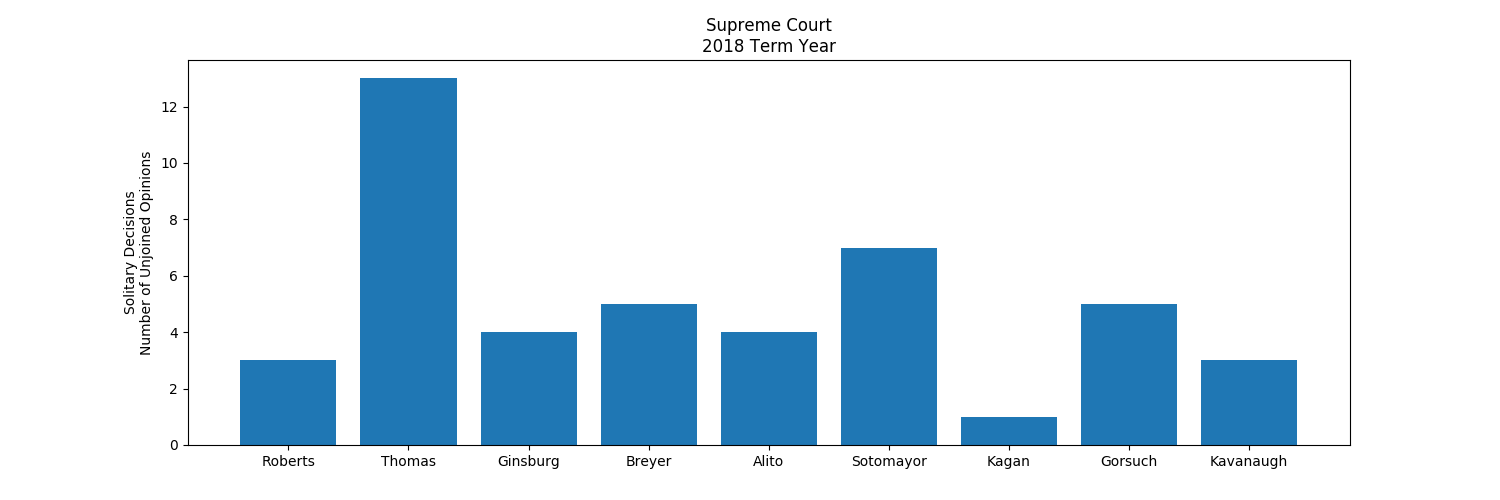
Count of Opinions Authored
Not Joined By Others
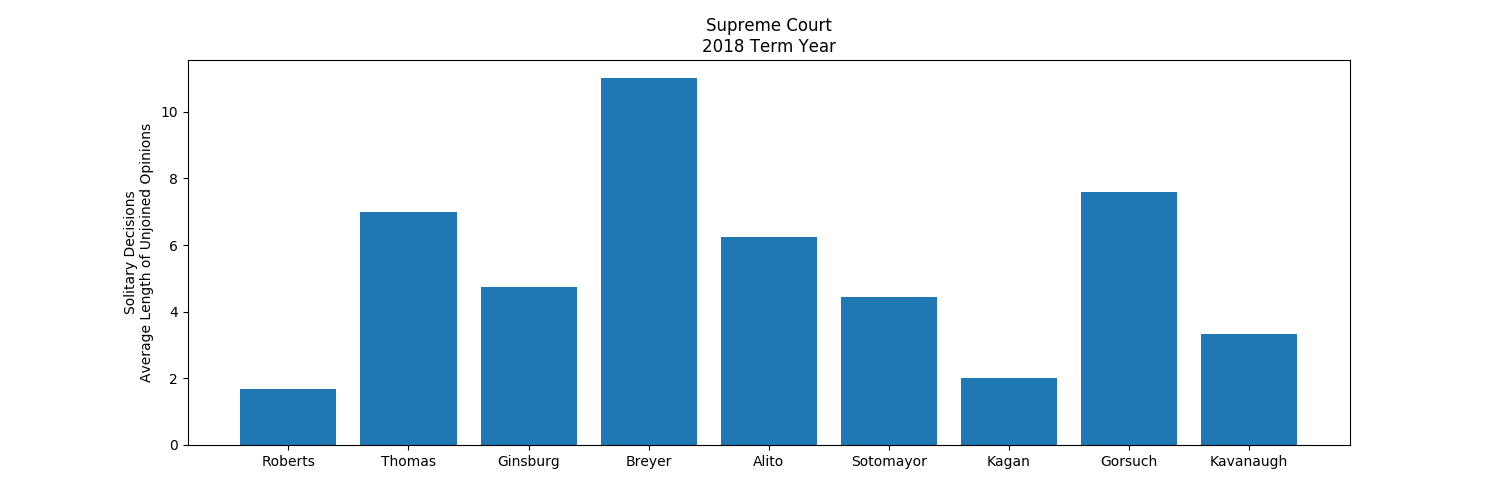
Average length of Opinions Authored
Not Joined By Others
As per above, except in tabular form:
Per the above, Thomas wrote more Opinions that no one else elected to join. I'm sure that's one of the reasons why he stood out at first. But sadly, where I once might have interpreted what he had to say as the voice of reason, that's not so much the case, anymore.
Also, I should note that some of these one off opinions (and other opinions, as well) include very interesting historical insight or other contextual information for the case at hand.
So although I am a big fan of the one page opinion (from a Legal Theory point of view), some of those longer Opinions are more useful from the perscpective of a Casual Reader.
Anyway, that was going to be it on the page, but I figure a Scatterplot showing the spread of Opinion lengths would be in order. But I'll probably end up doing that as a Bar Graph of Bins.
Eh, maybe I'll do both so it highlights why Bins are more appropriate.
| Judge | Number | Pages | Average |
|---|---|---|---|
| Roberts | 3 | 5 | 1.67 |
| Thomas | 13 | 91 | 7.00 |
| Ginsburg | 4 | 19 | 4.75 |
| Breyer | 5 | 55 | 11.00 |
| Alito | 4 | 25 | 6.25 |
| Sotomayor | 7 | 31 | 4.43 |
| Kagan | 1 | 2 | 2.00 |
| Gorsuch | 5 | 38 | 7.60 |
| Kavanaugh | 3 | 10 | 3.33 |
Per the above, Thomas wrote more Opinions that no one else elected to join. I'm sure that's one of the reasons why he stood out at first. But sadly, where I once might have interpreted what he had to say as the voice of reason, that's not so much the case, anymore.
Also, I should note that some of these one off opinions (and other opinions, as well) include very interesting historical insight or other contextual information for the case at hand.
So although I am a big fan of the one page opinion (from a Legal Theory point of view), some of those longer Opinions are more useful from the perscpective of a Casual Reader.
Anyway, that was going to be it on the page, but I figure a Scatterplot showing the spread of Opinion lengths would be in order. But I'll probably end up doing that as a Bar Graph of Bins.
Eh, maybe I'll do both so it highlights why Bins are more appropriate.
Opinion Length
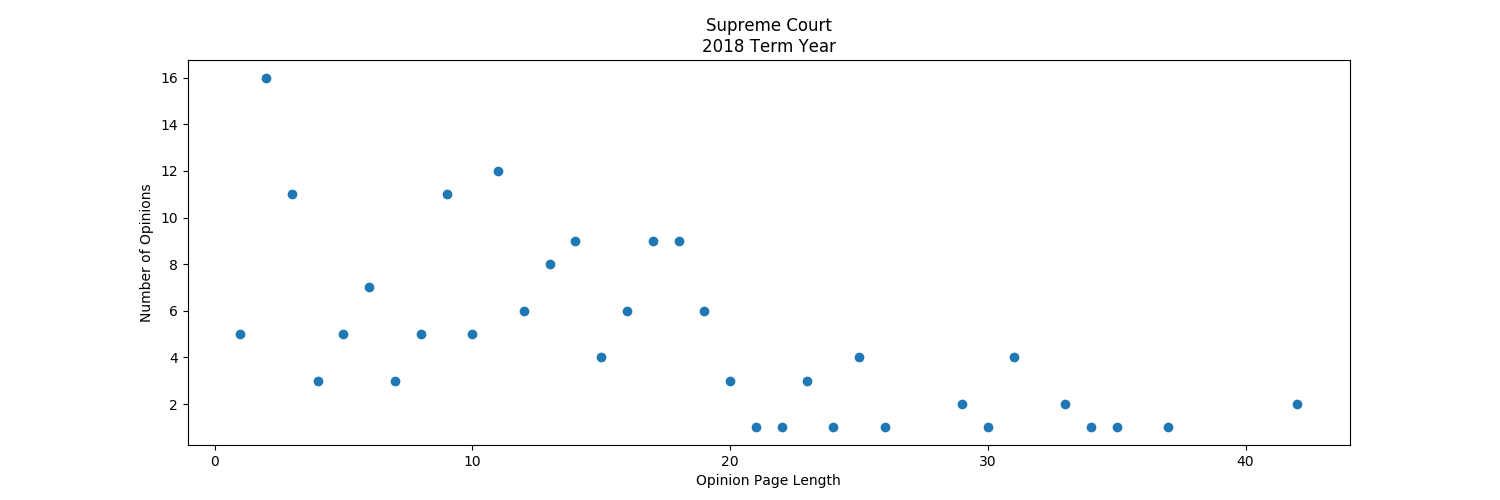
Opinion Length: Scatterplot

Opinion Length: Bar Graph (Binned Data)
It's not as obvious on the page. But when I flip back and forth between the two images, they overlap nicely.
I like to think the top Scatterplot highlights (quite nicely) how the data points grow thinner and thinner as the page length increases.
While the Bar Graph shows two nice lumpings. I'll call the first the Preferred Page Length, which goes from 0-20 pages technically, but likely groups better from 2-18 or something like that. And then, we have the outliers, as the page length increases.
I like to think the top Scatterplot highlights (quite nicely) how the data points grow thinner and thinner as the page length increases.
While the Bar Graph shows two nice lumpings. I'll call the first the Preferred Page Length, which goes from 0-20 pages technically, but likely groups better from 2-18 or something like that. And then, we have the outliers, as the page length increases.
Judging the Judges
Next Entry
Index
The Project Continues
Both For & Aft
Code For This Page
2018_judges_analyze_A3.txt
2018_judges_utilities.txt
Both For & Aft
Code For This Page
2018_judges_analyze_A3.txt
2018_judges_utilities.txt
© copyright 2020 Brett Paufler
paufler.net@gmail.com
A Personal Opinion/Editorial